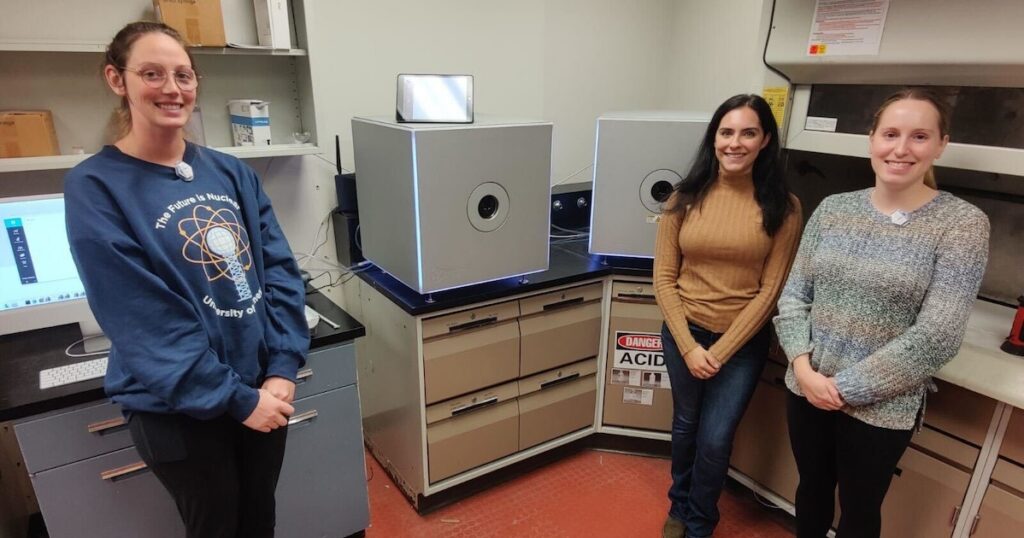Christmas came early for Graduate Research Assistant Alexis Sanwick. Learning that the University of Tennessee Department of Nuclear Engineering, with help from the college, UT Vet School, and UT Oak Ridge Institute, purchased $900,000 of new PET and CT imaging equipment was the best gift Sanwick could imagine.
“It made my entire day when I found out we were getting this,” Sanwick said. “It’s been a motivation to keep pushing through so that we get the chance to use it. It’s like a reward for all the work we are doing.”
The PET and CT equipment, which will be used on small animals like mice and rats, was installed in the Theranostics Development Lab at the UT Medical Center in December. The equipment expands the preclinical imaging and translational capabilities of the lab space and supports radioisotope research for health and biological applications.
“It really gives us the opportunity work with UTMC and utilize their facilities, but also gives them the opportunity to make use of some state-of-the-art research equipment by placing the equipment there,” Department of Nuclear Engineering Head Wes Hines said. “It’s just another example of good partnerships that we have and it’s great to see the relationship is growing.”
NE Assistant Professor Ivis Chaple Gore took a leading role in creating a coalition of UT support to help purchase the equipment. Chaple Gore’s research group designs, synthesizes, and characterizes radio pharmaceuticals. The group needed a small animal PET-CT to determine if radio pharmaceuticals are successful in targeting certain receptors. To be used in humans, FDA-approved drugs must first show the efficacy and determine the toxicity to animals.
“The equipment that we purchased is sort of novel in that they are benchtop imaging instrumentation,” Chaple Gore said. “Typically, ones that most have are kind of just smaller versions of a human PET-CT scanner and they tend to be much larger and bulkier. Because ours are so small, we have a PET and we have a CT and they are separate, which is great because we can use the PET and the CT simultaneously, so you don’t lose the ability to use CT or PET when the other is in use.”
The addition of the new equipment at the UTMC lab will enable a streamlined workflow at one centralized location. The lab has space for handling large amounts of radiation and will allow for the chemistry and research studies to be done in the same place.
“We are able to provide a unique educational experience that can be for nuclear engineers and radiochemists as well as radio pharmacists,” said Dustin Osborne, professor and director of the molecular imaging and translational research program (MITRP) at the UT Graduate School of Medicine. “Once that moves into developing this out, we have the opportunity to potentially have pharmacy people rotate through and see this production route.”
Sanwick, who has a bachelor’s degree in chemistry and master’s degree in medial physics, has already anticipated how much the new equipment will enhance her educational experience at UT.
“We are literally seeing our projects from the very beginning all the way to the end when doing these animal studies, which is not something that most even scientists in general get to do,” she said. “You have these ideas and wonder if they are feasible, and you can actually do them from start to finish through getting to use this equipment.”
Before UT purchased the equipment, Chaple Gore reached out to other departments on campus to find ways to collaborate on research projects in the future. Her group can help radiolabel compounds, as well as perform animal studies while providing image analysis, processing, and computing components.
Given there are no other small animal PET and CT scanners at one location in the East Tennessee area, Chaple Gore believes the new additions not only benefit UT, but the surrounding community as well.
“It really puts us on the map for nuclear medicine,” Chaple Gore said. “It is going to allow us to continue the great research that has been done in this area.”
Contact
Rhiannon Potkey (865-974-0683, rpotkey@utk.edu)
